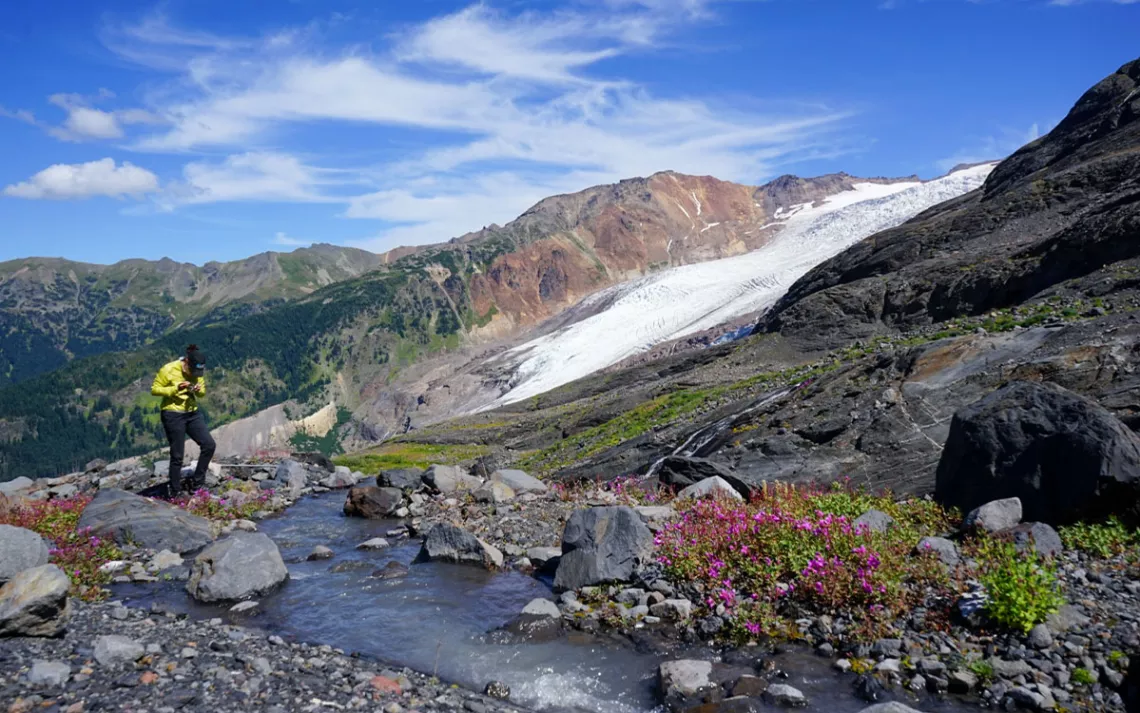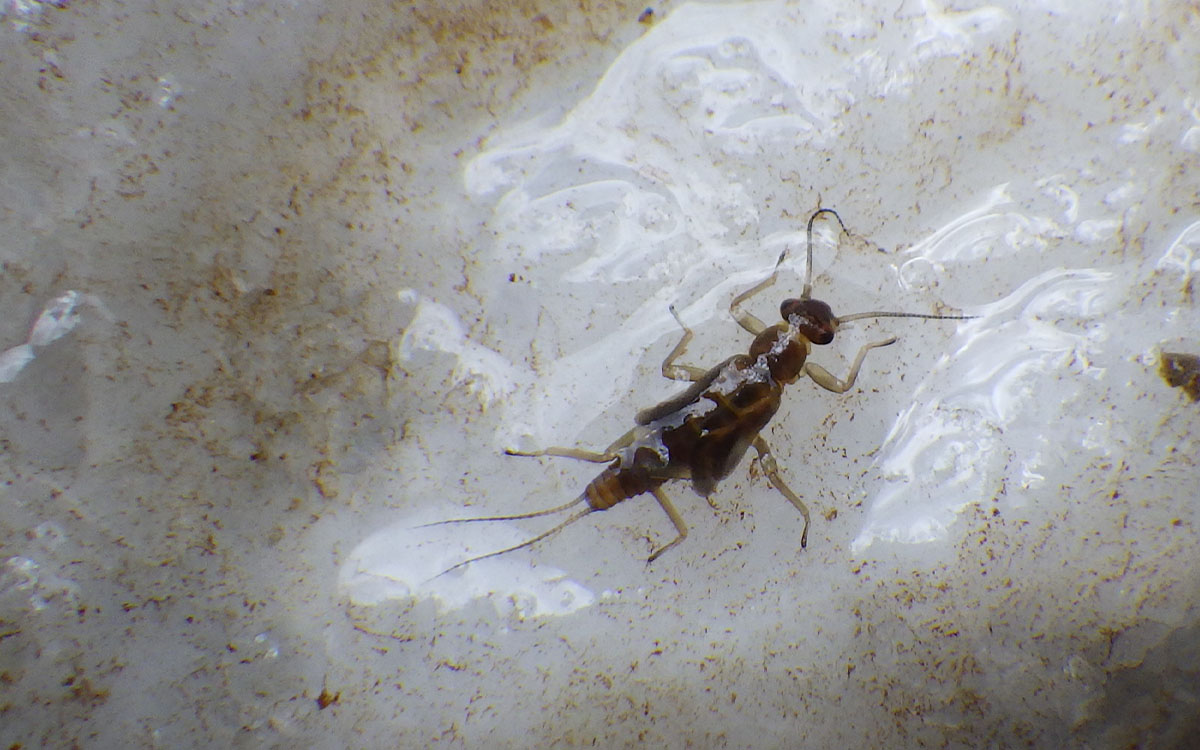Two Stoneflies Lead the Way for Conserving Other Uncharismatic Species
The Endangered Species Act protection of two alpine flies could help reshape the future of invertebrates worldwide

Xerces Society conservation biologist Emilie Blevins conducts fieldwork on Heliotrope Ridge in Washington. | Photo by Candace Fallon
In the summer of 2018, Joe Giersch crouched beside a mountain stream, surrounded by the picturesque peaks of Glacier National Park in northern Montana. Giersch wasn’t looking at the expansive landscape, though. Instead, he was bent over, eyes on the ground, carefully turning over water-smoothed rocks. He was searching for a creature no bigger than his fingernail, an aquatic insect known as a stonefly.
About 3,500 species of stoneflies populate the world, but Giersch was concerned with two especially rare ones—the western glacier and meltwater lednian stoneflies. Scientists have found the cold-loving insects within only about 50 miles of alpine streams and glaciers in western Montana and Wyoming. With rising global temperatures, that miniscule slice of habitat shrinks every year.
Recognizing the looming threat of climate change, in 2019, officials with the US Fish and Wildlife Service added both stoneflies to the list of threatened species the Endangered Species Act (ESA) protects. The addition of two relatively unknown insects broke many past patterns that have determined which species end up on the list and why. Scientists aren’t optimistic about the stoneflies’ future, but 50 years after Congress first passed the ESA, many are hopeful the species’ recent protection under the law could still set a precedent for safeguarding insects worldwide.
Every glacier in Glacier National Park has receded since the National Park Service began monitoring them in 1966, some by as much as 80 percent. Some historically perennial streams have begun to dry completely in the summer, as the melting ice that typically supplies them dwindles, and in the streams that remain, water temperatures continue to rise.
As an aquatic entomologist for the US Geologic Survey, Giersch spent nearly 13 years documenting how these changes will impact the western glacier and meltwater lednian stoneflies, along with a host of other high-alpine critters.
“It’s an entire community of insects that are just as rare and just as cold-water dependent,” Giersch said.
But even securing just the stoneflies’ protection was far from easy. WildEarth Guardians first petitioned for the listing of the meltwater lednian stonefly in 2007. The Xerces Society for Invertebrate Conservation and the Center for Biological Diversity filed a separate petition to list the western glacier stonefly in 2009. It would take a decade, a lawsuit and numerous treks into the mountains by Giersch and other researchers before Fish and Wildlife listed the stoneflies as threatened. (A threatened species is one that will likely become endangered in the near future, whereas an endangered species will likely become extinct in the near future.)
While such drawn-out legal battles are not uncommon when pursuing ESA listing, the process is often especially tough for less charismatic animals. Visitors to Glacier National Park can pick up a stuffed-animal grizzly bear, but they are unlikely to find memorabilia celebrating the stoneflies.
“Those photogenic megafauna are going to capture the imagination of more people, which I totally understand,” Giersch said. “They’re not coming to Glacier National Park to find some obscure little bug [insect] in a stream.”

Photo by Candace Fallon
The listing of not one but two stoneflies sets a couple of precedents. An estimated 250,000 to 500,000 insect species have gone extinct in the past 150 years, but only 100 of the ESA’s 1349 listed species are insects—a hugely disproportionate ratio compared to the biodiversity of insects worldwide, as well as their risk for extinction. As of 2023, the stoneflies are also two of only a handful of species listed because of the direct impacts of climate change on their populations. While climate change is considered harmful to many threatened and endangered species, Fish and Wildlife usually makes its listings based on threats from other human influences, such as deforestation, pollution, and the introduction of invasive species.
In this select group of climate-endangered species—which includes polar bears, spotted seals, the Florida salt marsh vole, and a few species of penguins—the stoneflies stand out as the only invertebrates and some of the only species residing outside of the Arctic or Antarctic.
While the stoneflies' listing may have been groundbreaking, researchers worry it is already too late to save the western glacier and meltwater lednian, warning that the glaciers providing the stoneflies with habitat in northern Montana could completely disappear as early as 2050. Wildlife officials seem to share this worry. The Fish and Wildlife Recovery Plan for the two stonefly species focuses on manually relocating the insects to new streams, and drafting protocols for breeding the insects in captivity, but reducing the effects of climate change is “the most important recovery action.” The plan goes on to say that tackling climate change is “daunting” and “require[s] global action.”
This admission didn’t surprise Scott Hotaling, associate professor of watershed science at Utah State University. After monitoring stonefly populations in northwestern Wyoming’s Grand Teton National Park for years, he has become pessimistic about the ability of the western glacier and meltwater lednian stoneflies to survive in the wild.
“The elephant in the room, the overarching thread that threatens this species and everything like them, is our carbon emissions,” Hotaling said.
Climate change could cause the extinction of one in every six species, say University of Connecticut researchers. The risk is even greater for cold-blooded animals, such as insects, which lack the ability to self-regulate their body temperature. According to a recent study from NASA, 65 percent of the world’s insects are at risk of extinction, in large part due to anthropogenic climate change.
“It doesn’t really matter what we [scientists] do,” Hotaling said of efforts to save these two stoneflies without also lowering carbon emissions. But he still hopes that even if the western glacier and meltwater lednian stoneflies go extinct, their novel addition to the threatened and endangered species list will prove beneficial to the numerous other invertebrate species threatened with climatic changes and glacial melt.
Hotaling first became interested in the cryosphere—which includes glaciers and other forms of frozen water—after working as a climbing ranger on Mount Rainier in Washington State, the most glaciated mountain in the contiguous United States. The job required him to live on a glacier for four months. At first, the landscape seemed barren, a virtual wasteland save for a few mountaineers swaddled beneath layers of hi-tech polyester and nylon. But as the summer wore on, Hotaling said, he began to notice signs of life: ice worms, algal blooms, birds that would land on the ice to feed on invertebrates.
After that summer, Hotaling shifted his focus to study glaciers and the biodiversity they support. He joked that a study about lemurs he coauthored early in his career garnered more attention than any of his more recent cryosphere work, but the lack of recognition has only motivated Hotaling to draw awareness to an often-overlooked, but nonetheless important, ecosystem.
“I mean, these are literally the headwaters of the earth,” Hotaling said. “There’s really important practical ties between these areas and the daily lives of people.”
For Hotaling, federal recognition of the stoneflies is a step in the right direction for alpine environments and the hidden biodiversity they support. The western glacier and meltwater lednian stoneflies, as well as other aquatic insects, maintain the health of streams by cycling nutrients in the water and serving as prey for larger animals.
While the disappearance of a couple rare stonefly species likely wouldn’t cause immediate ecological collapse, it is also unlikely they would be the only victims. Nearly half of North American stonefly species are either in danger of extinction or already extinct. The western glacier and meltwater lednian stoneflies are merely the first to achieve federal recognition.
During the summer of 2022, in another mountain range 500 miles west of Glacier National Park, Candace Fallon hiked along a streambed. The landscape of the Cascades Range in Washington largely mimics its counterparts in Montana and Wyoming, with towering peaks offset by U-shaped valleys. As she hiked, waterfalls careened down cliff sides, flushing the alpine habitat with cool clear glacier melt.
Fallon knelt in the meltwater, ignoring its frigid temperatures to pluck rocks one-by-one from the streambed. She wasn’t searching for western glacier or meltwater lednian stoneflies, though. She was searching for a species that may be even rarer—the northern forestfly (known scientifically as Lednia borealis; its common name belies that the northern forestly is indeed a stonefly).
At first glance, it looks nearly identical to the meltwater lednian stonefly. The two species were even thought to be the same until 2010, when new genetic technology confirmed there are, in fact, four distinct species of lednia stoneflies.
As a senior endangered species conservation biologist for the Xerces Society for Invertebrate Conservation, Fallon had been tasked with figuring out where the formerly unknown species existed in the wild. She joined forces with a team of other researchers from the Xerces Society and Washington Department of Fish and Wildlife to survey 94 streams between 2015 and 2019. The team found forestflies at only eight sites, all of them in the shadow of the Northern Cascades’s retreating glaciers.
While the northern forestfly faces the same threats as the western glacier and meltwater lednian stoneflies, it is not yet listed under the ESA. Fallon said the Xerces Society may pursue a federal listing for the northern forestfly in the future. If so, she believes the western glacier and meltwater lednian stoneflies will serve as important examples.
“It is encouraging that these other species were listed, especially because they were listed because of climate change,” Fallon said. “It’s an interesting precedent.”
The State of Washington included the northern forestfly, along with seven other stonefly species, in the 2015 State Wildlife Action Plan. Like the ESA, State Wildlife Action Plans create protocols for monitoring rare species and outline suggestions for future conservation activities to maintain wildlife populations. While inclusion on a State Wildlife Action Plan doesn’t guarantee attention or resources, the northern forestfly’s status as a “species of greatest conservation need” in Washington likely helped Fallon’s team secure grant funding to continue researching the insects. It could also be a point in the forestfly’s favor if Fish and Wildlife one day consider it for the threatened and endangered species list.
Yet as she descended the mountain under a high afternoon sun this past summer, Fallon couldn’t help but feel a twinge of disappointment. There were no northern forestflies that day, a fact both largely unsurprising and disquieting.
Like Giersch and Hotaling, Fallon said that she can track the rapid retreat of the glaciers through her years of fieldwork. She knows that the northern forestfly faces monumental challenges in the coming decades.
“It’s hard not to feel hopeless,” Fallon said. “But I don’t want to feel hopeless.”
A decade after its discovery, it may already be too late to save the northern forestfly, just as it may be too late to save the western glacier and meltwater lednian stoneflies, but momentum is building in other ways.
Over the past 10 years, 24 insects, including the two stoneflies, were added to the ESA, and while the gift store memorabilia may be lacking, educational signs on popular trails in Glacier National Park now teach visitors about the threatened stoneflies and climate change. Off the beaten path, scientists like Fallon and Hotaling continue to study rare invertebrates, building a base of knowledge that may one day be used to secure legal protections.
Whether they become climate change martyrs or conservation miracles, the western glacier and meltwater lednian stoneflies represent hope, not for an end to carbon emissions or the reversal of glacial melt but for the expansion of wildlife protections to include all creatures. Even the creepy crawly ones.
This article has been updated since publication.
 The Magazine of The Sierra Club
The Magazine of The Sierra Club



